Medical devices, also widely known as life science devices, are an indispensable part of modern medicine and an important basis for protecting human health. The field of medical device circulation is a key component of the medical industry. The smooth circulation of medical devices can ensure the timely and safe delivery of medical devices from producers to end users. With the rapid development of life science research and technology, the field of medical device circulation has ushered in unprecedented new opportunities and new challenges.
I have been engaged in professional services in the field of medical device distribution for more than 20 years, and have outstanding expertise and rich experience in this field. According to my experience and research on the development of the field, the field of medical device circulation can not only promote the innovation and development of the medical device industry, but also make a significant contribution to improving the level of human health. Therefore, I am convinced that the field of medical device circulation is an indispensable link in the life science research and application transformation, and brings immeasurable value to the health care industry.
In the following, I will discuss and analyze the close relationship and balance between the internal and external of medical device distribution and life sciences.
1. Medical device circulation is a key link in life science research and application transformation
Medical device circulation is an integral part of life science research and application transformation. Life science research and application transformation depends on the infrastructure and supporting systems, including various instruments, reagents, software, etc., which together promote major discoveries and results transformation in life science.
For example, the invention of microscopes, gene sequencers, and bioinformatics software has greatly improved the breadth, depth, accuracy, and efficiency of scientific research work, and translated scientific research results into practical applications more quickly. The invention of the microscope and advances in imaging technology have allowed researchers to observe the structure and function inside cells, even at the nanoscale, which is crucial to understanding complex life processes. At the same time, the emergence of gene sequencing technology has allowed researchers to obtain a large amount of genetic data, and gave birth to the field of "genomics", scientists through bioinformatics software to parse these genomic data, in order to reveal the molecular basis of disease, to identify the genetic mutations and genetic variations that cause disease.
Life science research has developed from traditional observation and analysis of known life phenomena and mechanisms to interdisciplinary integration, exploration of unknown areas and applications, and even the creation of new functions and systems. Life science research has developed a number of new research fields and disciplines, such as brain science and neuroscience (brain-computer interface and neurological disease research), synthetic biology (new drug development and biofuel production), microbiome (intestinal health improvement and environmental governance), aging biology (anti-aging drugs and gene therapy) and so on. Advances in these areas have addressed many real-world problems and improved human health and quality of life.
Advances and innovations in life science devices have played a key role in this process. On the one hand, the emergence of advanced tools can give birth to new research directions and promote research breakthroughs; On the other hand, the development needs of the research direction will also promote the development and improvement of the corresponding tools. Therefore, the innovation and application of life science instruments have a profound impact on the process of life science research and transformation.
Among them, research breakthroughs in innovative drugs, diagnostic tools and treatment methods have improved the quality of life of patients, met social needs, had huge commercial value, and attracted a large amount of capital investment. Institutions such as academic and government research institutions, pharmaceutical companies, biotechnology companies, hospitals and clinics, and international research cooperatives are the main users of life science tools, and many countries reduce the risk of research projects and promote the commercialization of technologies and tools through policy support for relevant institutions. With the advancement of standardized production, advanced technological tools are widely used, and the accumulation of professional talents and knowledge jointly promotes the continuous growth of the life science tool industry, thus driving the overall industrialization of life science. The overall industrialization of life science operation needs the support of the medical device circulation field.
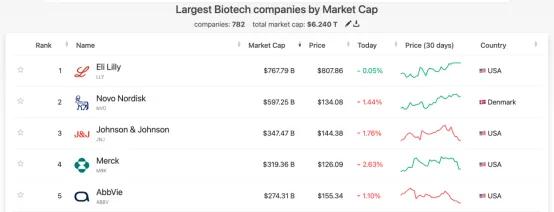
29/05/2024 https://companiesmarketcap.com/biotech/largest-companies-by-market-cap/
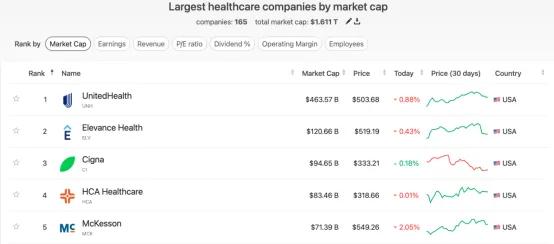
https://companiesmarketcap.com/healthcare/largest-healthcare-companies-by-market-cap/
2. Production and innovation analysis of life science instruments
For example, in drug and vaccine development, these tools are indispensable from research screening and testing to production. Therefore, they are not only the pillar of research, but also an important link to promote the transformation of research results into applications, and ultimately form a complete life science industry ecology.
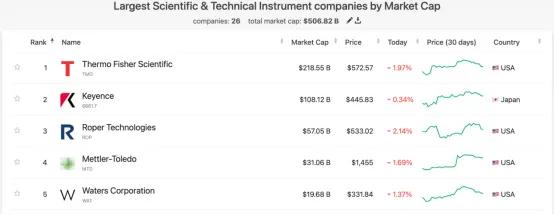
https://companiesmarketcap.com/scientific-and-technical-instruments/largest-scientific-and-technical-instrument-companies-by-market-cap/
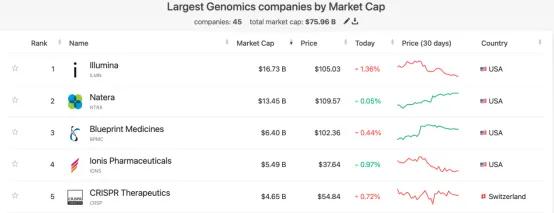
https://companiesmarketcap.com/genomics/
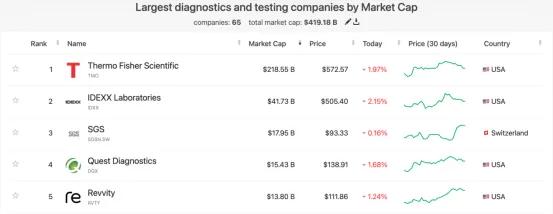
https://companiesmarketcap.com/diagnostics/

https://companiesmarketcap.com/crispr/
3. Medical device/life science tools industry categories and applications
A wide range of medical device/life science tools support research in genes, cells, tissues, metabolites, synthetic biology, and vaccine and drug development and production.
Laboratory equipment such as microscopes and centrifuges are used for biological experimental research; imaging techniques such as MRI are used to observe tissue cells; analytical instruments such as mass spectrometers are used to analyze molecular metabolites; gene sequenters are used to obtain gene sequences and establish databases; potential vaccine and drug targets can be identified through bioinformatics analysis software; drug design software is used for virtual screening and optimization of drug molecules. Molecular biology reagents consumables are indispensable in experimental operations, animal models are used in clinical trials, fermenters, cold chains, etc. are used in pharmaceutical vaccine production, and of course, the gene editing tool CRISPR, so many tools they provide powerful support for life science research, from theory to product development and production.
Related companies such as Thermo Fisher Scientific, Keyence, Illumina, IDEXX, CRISPR Therapeutics, etc., occupy an important position in the industry.
公司全称 | 公司网站 | 主要产品和服务 | 市值 (亿美元) | 国家 |
Thermo Fisher Scientific Inc. | https://www.thermofisher.com/ | 科学仪器、实验室设备、试剂和软件 | 2213 | 美国 |
Keyence Corporation | https://www.keyence.com/ | 传感器、测量系统、激光打标机、显微镜和机器视觉系统 | 1686 | 日本 |
Illumina, Inc. | https://www.illumina.com/ | DNA测序仪和试剂 | 377 | 美国 |
IDEXX Laboratories, Inc. | https://www.idexx.com/ | 兽医诊断产品、乳制品质量和水质检测 | 351 | 美国 |
CRISPR Therapeutics AG | https://crisprtx.com/ | 基因编辑技术及疗法 | 307 | 瑞士 |
Danaher Corporation | https://www.danaher.com/ | 测试测量、环境、生命科学服务和诊断设备、牙科和工业技术 | 271 | 美国 |
Medtronic plc | https://www.medtronic.com/ | 医疗设备 | 251 | 爱尔兰 |
Charles River Laboratories International, Inc. | https://criver.com/ | 实验室耗材和试剂 | 248 | 美国 |
Agilent Technologies, Inc. | https://www.agilent.com/ | 科学仪器、实验室软件和服务 | 234 | 美国 |
Source: https://finance.yahoo.com/
https://www.reuters.com/
Note: The market value is calculated based on the closing price of the company's shares on December 31, 2023
At present, the world's leading life science industry enterprises are mainly concentrated in Europe and the United States and other developed economies, from the above data is not difficult to see that the United States has the world's most advanced and most mature life science research system and research life science equipment industrial system, is currently the world's largest life science equipment application market.
Not only Western countries, but also other countries in the world, including many countries in Asia, have also made great contributions to the development of life science research and the application of life science instruments. For example, China's BGI is a world leader in the field of gene sequencing, helping to rapidly reduce the cost of personal sequencing; South Korea's Celltrion launched the world's first "antibody biosimilar"; The RIKEN Research Institute of Japan (RIKEN) has made significant advances in genomics, regenerative medicine, and neuroscience. Research institutions and companies in these countries drive global progress and collaboration in the life sciences in areas such as genomics, biotechnology and public health.
4. The gap between innovation, application promotion and commercial circulation of medical devices/life science devices
The medical device/life science tool circulation is highly specialized and requires specialized knowledge and skills to properly operate and understand functions and applications. Genetic sequencing equipment, for example, requires specially trained personnel to effectively use and interpret the data it produces, which is very different from the situation where ordinary commodity consumers can easily use it. Moreover, different life science tools have a precise range of application for specific research fields, types of experiments or disease diagnosis, and the application scenarios are highly differentiated. This makes their promotion and circulation can not be generalized, and it needs to be customized for specific professional fields and user groups.
In addition, the replacement of medical device circulation/life science devices is very fast, and new technologies and products continue to emerge, which puts higher requirements on application promotion and commercial circulation. In the commercial circulation, the establishment and maintenance of channels is also more complex, involving a number of different natures of the main body, the need for targeted service models. At the same time, due to the professionalism and high value of the industry, immersive technical explanations and case presentations are often required in marketing to help users understand the value and advantages of these tools. In view of the many challenges and requirements facing the application and commercial circulation of life science tools, we need to take active and effective countermeasures. For example:
§ Build a professional demonstration laboratory to follow up the frontiers and hot spots of life science research, and directly demonstrate the functions and effects of life science instruments in these key areas, such as gene sequencers, single-cell sequencers, mass spectrometers, etc. The demonstration by professional operation experts allows visitors to have a deeper and more accurate understanding of the operation process, advantages and application scenarios of the innovative equipment. Not only does it help potential customers visualize the product, but it also provides them with a reference for practical applications, accelerating their acceptance and adoption of these innovative tools. At the same time, it can also attract more target groups to come to experience, publicize and educate through regular open days and appointment visits.
Building international communication platforms and social organizations for industry founders can promote exchanges and cooperation between domestic and foreign industry founders. Through regular meetings, seminars, forums and other activities to share experience, explore trends, exchange technology and business ideas, promote international cooperation opportunities. Invite well-known industry leaders, experts and scholars, and policy makers to participate together, become an important channel for resource integration, promote technology transfer, project cooperation, etc., and promote the overall development of the life science tool industry.
§ Online product, technology display and trading platform with the help of the Internet. Break the time and space restrictions, so that more people understand and access to life science tools. For example, through high-definition video display, detailed product introduction, AI virtual demonstration, etc., the characteristics and advantages of the tool are fully presented. Online trading platforms simplify the transaction process and improve the efficiency of commercial circulation. At the same time, it can combine big data analysis and other technologies to accurately push product information to potential customers and improve marketing effects. It can also enhance the interaction between users and enterprises through online live broadcasting, Q&A interaction and other forms to solve users' questions and needs in a timely manner.
Medical device/life science device distribution is a market full of opportunities and challenges. With an aging population, advances in medical technology and healthcare reform, this market needs to continue to grow. With more than 20 years of expertise and experience in the field of medical device distribution, I am convinced that this industry will continue to inject vitality and impetus into the development of human health and make great contributions.
|
Last:Reprint: In the big data of endoscopic ultrasound in 2024, domestic brands ranked first
Next:Reprint: Analysis of driving factors of hyaluronic acid industry in China in 2024 |
Return |